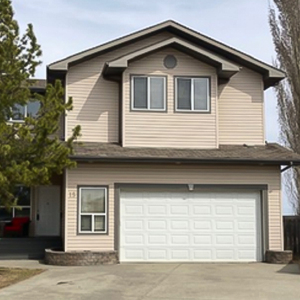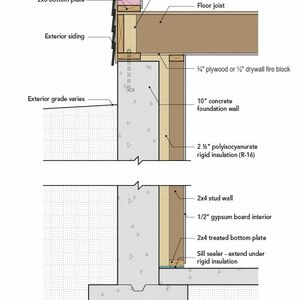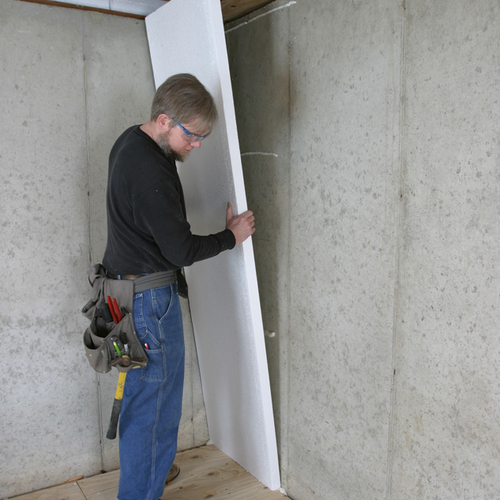
A homeowner in Minnesota, “SG_TM,” has posted a question concerning their plan for a finished room in the basement. They intend to frame 2×4 walls, spaced an inch from the concrete, and insulate them with R-15 fiberglass batts. Although there hasn’t been any evidence of water leaking into the basement, they are worried that if they insulate with rigid foam board or spray foam against the concrete, any water coming in through the foundation will create mold and/or mildew. (Also, their budget doesn’t allow for spray foam.) SG_TM wants to know if fiberglass would be a better choice than rigid foam, or whether they should insulate at all.
So, what’s the best way to insulate a partially finished basement in a cold climate? Do fiberglass batts make sense in this situation? That’s the topic for today’s Spotlight.
Air permeable insulation in a basement
The response is a chorus of “Nos!” led by Martin Holladay, who writes, “You don’t want to use fiberglass to insulate the interior side of a basement wall.” He points readers to two articles he wrote that explain the reasons: How to Insulate a Basement Wall and Three Ways to Insulate a Basement Wall.
As Holladay, “freyr design,” and “DennisWood” all attest, fiberglass insulation would allow the warm, moist air in the conditioned finished room to condense on the cold foundation walls, which would likely lead to mold and/or mildew growth behind the walls.
To help prevent water from seeping in through the foundation, freyr design suggests sealing the concrete with a fluid-applied membrane like Red Guard, and creating an interior French drain system to handle any liquid build-up.
DennisWood counters that advice with a story of a vapor retarder that failed, resulting in wet fiberglass and mold…
Weekly Newsletter
Get building science and energy efficiency advice, plus special offers, in your inbox.

This article is only available to GBA Prime Members
Sign up for a free trial and get instant access to this article as well as GBA’s complete library of premium articles and construction details.
Start Free TrialAlready a member? Log in















8 Comments
I'm surprised that no one pointed out that the code no longer distinguishes between finished and unfinished space when insulating basements. This is something that's important to reinforce because there is a persistent belief that unfinished spaces don't need to be insulated.
I know vapor-sealing the inside of masonry basement walls with a fluid applied VB and/or CCF is commonly done but I always tell people this has to be thought about very carefully and comprehensively especially taking into consideration what the first wood sill plate connection is to the top of that masonry wall. If you seal the wall from the inside and if it's also sealed above grade from the outside then 100% of the water carrying vapor will hit the bottom of your first wood sill plate. If construction is recent w/ sill sealer and maybe some flashing and PT plate then you MIGHT be fine forever but if it's an old home that relied on old growth non-treated first plate I would say not to drive all the moisture to that plate.
I make sure to detail and warn NEVER to CCF over the first wood band joist above the masonry wall so that I know it can dry to the inside. Instead I spec rock wool for the insulation of that first band joist which is vapor open in case that band joist ever sees moisture or vapor drive.
What kind of climate are you in? In heating climates, why would that band joist not dry to the outside like the rest of the exterior walls?
In a heating climate, that band joist most needs to be protected against moisture from the interior.
I have a semi conditioned basement in Nebraska zone 5. I’ve been nervous about insulating inside but I just don’t have the money to do the full exterior project. Basement has no bulk water issues but the comments here have me confused again if I should cover the bottom plate and rim joist or not. The exterior I’m sure has no rain screen. Perhaps has felt paper, then I know the old aluminum siding is covered with vinyl siding.
Climate Zone 4A. So it gets both very cold and very hot and humid outside. If I had a rainscreen then MAYBE I would get on your page however I have regular cladding (cement siding) over self adhered vapor permeable henry blueskin WRB. But near the basement wall I have about 4-6" of impermeable aluminum flashing detail where the siding ends. Also I can't control how humid it gets outside but I know my finished basement NEVER sees humidity levels above 60% because I mechanically control that. I don't understand how ppl can live without controlling the humidity in their home pinpoint exhaust over showers and cooking appliances and with dehumidifiers when needed. A comprehensively-designed home should control humidity levels at the sources (cooking, showering, basements & crawl spaces).
60% RH in the basement is enough to cause condensation on a surface exposed to the outside. If your wall can't dry to the outside you need to have impermeable insulation at least to the point where the interior is warm enough not to be a condensing surface. The rim joist behind that unfaced insulation is going to be wet all winter.
Treating the exterior surface of the masonry wall above grade: In my home I placed an open rain screen over this portion of the wall to ensure that it never takes on moisture from rain fall / bulkwater but is always given the opportunity to dry to the outdoors via the stratification effect of the dark colored rain screen. Minerals wool exsulation against the masonry breaths really easily allowing the wall to always dry.
Log in or become a member to post a comment.
Sign up Log in